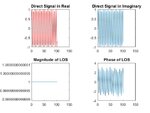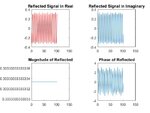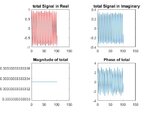nateduong
Newbie level 3
Hi everyone,
I am a new engineer just work in the real industry, so I would like to collect more experience from the real project.
I am working on the Multipath problem, but I've not done before in the University, and really do not know how to solve it.
During the discussion from the professor which I can wrote down from the pdf file (attached below).
My responsibility: how to detect multipath?
Here are what I have?
0. Choose the simplest situation that is 1 direct signal and 1 multipath signal.
1. Center frequency of the TV station: fc = 533 MHz, and bandwidth: B = 6 MHz
2. Equation for electromagnetic: k = 2*pi/λ
3. Distance between 2 RX antennas : d1 = 10 cm (Software Define Radio with dual antenna)
4. Time delay indoor : ζ from 10 - 1000 (ns)
5. Angle θ = ± pi/2 ( everytime turn the angle pi/2 or -pi/2) (angle between RX and TX)
6. Distance between 2 RX antenna to TX antenna d2 = 4.3 km
7. Amplitude: a0 = 1 (a0 is amplitude for direct signal LOS)
a1 = [0 1) (a1 is amplitude for multipath signal 1)
8. Equation for multipath: MUL = ∑ an * exp(j*(k*(x*cosθ + y*sinθ) - w( t - ζ )))
I do not know I did right or wrong? But If anyone who has done this before, please confirm with me, I would appreciate so much.
and If I did not do right, how I can fix it. Please give me suggestions.
Thank you very much.
I am a new engineer just work in the real industry, so I would like to collect more experience from the real project.
I am working on the Multipath problem, but I've not done before in the University, and really do not know how to solve it.
During the discussion from the professor which I can wrote down from the pdf file (attached below).
My responsibility: how to detect multipath?
Here are what I have?
0. Choose the simplest situation that is 1 direct signal and 1 multipath signal.
1. Center frequency of the TV station: fc = 533 MHz, and bandwidth: B = 6 MHz
2. Equation for electromagnetic: k = 2*pi/λ
3. Distance between 2 RX antennas : d1 = 10 cm (Software Define Radio with dual antenna)
4. Time delay indoor : ζ from 10 - 1000 (ns)
5. Angle θ = ± pi/2 ( everytime turn the angle pi/2 or -pi/2) (angle between RX and TX)
6. Distance between 2 RX antenna to TX antenna d2 = 4.3 km
7. Amplitude: a0 = 1 (a0 is amplitude for direct signal LOS)
a1 = [0 1) (a1 is amplitude for multipath signal 1)
8. Equation for multipath: MUL = ∑ an * exp(j*(k*(x*cosθ + y*sinθ) - w( t - ζ )))
I do not know I did right or wrong? But If anyone who has done this before, please confirm with me, I would appreciate so much.
and If I did not do right, how I can fix it. Please give me suggestions.
Thank you very much.
Code Visual Basic - [expand]
Attachments
Last edited by a moderator:


